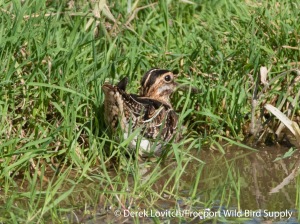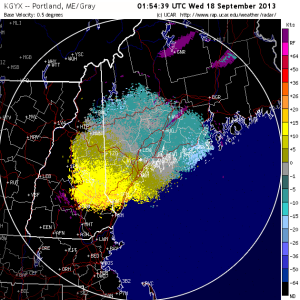
I do love it when the big ones fly by, especially on mornings like this. They’re easier to identify and tally…especially when they are Pileated Woodpeckers!
It’s also nice when more birds pause in the trees at the point, allowing for identification as a “sample” of what’s going overhead. It’s especially nice when they land in front of my face…like this Philadelphia Vireo did. If only there weren’t a few twigs between us!

I usually leave the bridge before raptors begin to get going, but today, I was treated to an early-morning Peregrine Falcon flight. A couple of the birds didn’t even blink and eye and kept going. Others terrorized migrant flickers.

Normally, I start off with the overnight radar analysis to describe why there were (or were not) so many birds come morning. But today, let’s cut to the chase and get right to the numbers:
6:32-10:10am
43F, light NW, mostly cloudy, slowly clearing.
1662 Unidentified (*2nd highest)
441 Yellow-rumped Warblers (*2nd highest)
263 Northern Parulas (how are there still so many parulas!?)
193 Black-throated Green Warblers (*2nd highest)
188 Ruby-crowned Kinglets (*2nd highest)
150 Northern Flickers
56 Golden-crowned Kinglets
52 Magnolia Warblers (*2nd highest)
46 Black-throated Blue Warblers (*new record; old = 13!)
44 Cedar Waxwings
44 Dark-eyed Juncos
41 Black-and-white Warblers (*2nd highest)
31 Red-eyed Vireos
29 Blue-headed Vireos (2nd highest)
27 Blackpoll Warblers
26 Eastern Phoebes (*new record)
26 Nashville Warblers (*new record)
23 Palm Warblers
22 Yellow-bellied Sapsuckers
15 American Robins
15 American Goldfinches
14 Blue Jays
12 Scarlet Tanagers
12 Rusty Blackbirds
9 White-throated Sparrows
8 Eastern Bluebirds (*new record)
7 Philadelphia Vireos
7 Chipping Sparrows
6 Peregrine Falcons (*new record)
6 Unidentified vireos
6 Brown Creepers
5 Yellow Warblers
4 Tufted Titmice (*new record)
4 Rose-breasted Grosbeaks
3 Black-capped Chickadees
3 Tennessee Warblers
2 Sharp-shinned Hawks
2 Cape May Warblers
2 Wilson’s Warblers
1 Red-breasted Merganser (first of fall)
1 Common Loon
1 American Kestrel
1 Merlin
1 Mourning Dove
1 PILEATED WOODPECKER (my third crossing ever; crossed after 4 false-starts)
1 RED-BELLIED WOODPECKER (crossed after 3 false-starts)
1 Warbling Vireo
1 Red-breasted Nuthatch
1 White-breasted Nuthatch
1 Swainson’s Thrush
1 Bay-breasted Warbler
1 Common Yellowthroat
1 Swamp Sparrow
1 Lincoln’s Sparrow
1 DICKCISSEL (4th of season)
1 Red-winged Blackbird
Total= 3523 (*third highest total)
So there you have it. Wow. <Insert various superlatives and/or swear words> I just wish I could have whittled down that unidentified total a little bit more – who knows how many single-species records I might have set?
There were two reasons the unidentified tally was so high. One is that early-morning cloud cover once again reduced many of the birds to silhouettes. Secondly, the intensity of the first two hours of the flight was really exceptional. On multiple occasions, I could do nothing more than step back look up, smile, and click off a cloud of unidentified warblers – no point of even lifting the binoculars. Bunches of birds high overhead; I’d follow one bird into the Magic Elm, and 20 would shoot out. Birds were sneaking below me. It was, at times, a bit overwhelming! But it was also exceedingly fun; I like the challenge, and since my interest lies in quantifying the flight as much as identifying the composition of it, the high unidentified tally only bothers me a little…OK, maybe a little more than a little, but anyway…
I couldn’t resist taking a few photos, such as the Philadelphia Vireo landing in front of me, or the majestic Pileated Woodpecker cruising by. 16 species of warblers, a bunch of new records and near-records, and some “good” birds. Yeah, that’s a good flight. But I actually think my highlight was one little female American Redstart. She dropped in from high overhead, straight down into the regenerating cherry that stands directly in front of me (and perfectly blocks the sun from my eyes for the first hour of the day) – the one the Philly V was in – and hopped her way to the near edge. She looked at me, and cocked her head to look at the camera lens that was lying down next to me. I am guessing she saw her reflection. She looked at me, chirped in a gentle contact call – not the harsh alarm call or even the sharp flight call – and then hopped back into the brush. We had a moment. I enjoyed that.
OK, back to business…the radar. Save these images for future reference. This is what “GO BIRDING IN THE MORNING!!!” looks like. Here are the 10pm, 12am, 2am, and 4am radar and velocity images for example <insert “boom” sound>:








Even at 6:00am, with light more than peaking into the eastern sky, birds were still on the move. If I had not expected to go to SandyPoint for sunrise this morning, and I had seen this image, I would have flown out the door.


When there are this many birds in the air so close to sunrise, there are going to be a lot of birds taking part in the “morning redetermined migration” come dawn, along with crepuscular migrants that are moving in the early light. The radar provided all of the suggestions of a big flight. And, with a light northwesterly breeze, many more birds were low and in the trees than on the westerly breezes of the last few mornings. Here’s the wind map, showing that low moving off of the Maritimes, ushering in a north to northwesterly flow behind it – as I postulated on my blog yesterday.

While I am rarely even at Sandy Point for four days in a row, it is exceedingly rare that the fourth day would be so busy. But I think that upper level low finally pulling out of the way re-opened the floodgates. And it looks like tomorrow should be good as well, continuing a most impressive string of good flight nights. But I will give my neck a break tomorrow from staring straight up and spinning back and forth at Sandy Point. Instead, I’ll just have to see what the flight will be like with my tour on Monhegan Island. Yeah, I know, tough life.
































































